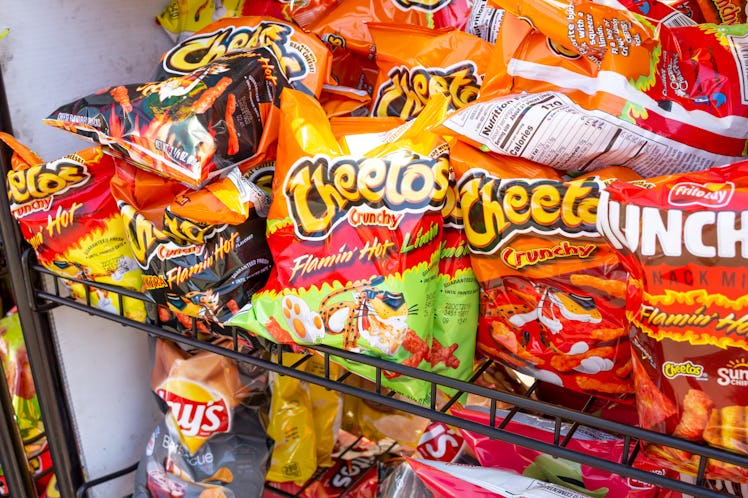Spicy Food Is Dangerous For Kids — But Not In The Way You Think
Some kids are obsessed with spicy food. Parents should be wary of that.

On any trip to a convenience store, it’s hard to avoid the red hot spices thrust in your face. From Takis to Flamin’ Hot Cheetos, there’s a fetish for spice in snack foods right now — and it represents a serious health hazard.
Take, for example, the 'One Chip Challenge' — a viral internet challenge in which you consume a Paqui chip flavored with Carolina Reaper, which previously held the Guinness World Record for hottest pepper. The challenge gained popularity through social media, but it’s been blamed for making several children ill, hospitalizing others, and even killing one teenager.
But the One Chip Challenge is an extreme example. Not a spicy food so much as a weaponized delivery system for capsaicin, the One Chip Challenge highlights the potential dangers associated with pushing spice to the extreme. More pressing to kids is the health risk that everyday spicy foods presents to their diet.
This might be confusing given the prevailing (and well-evidenced) notion that spice, especially capsaicin, found in the skin of chili peppers, is good for you. One study, for example, found that people who eat spicy food nearly every day have a 14% lower chance of dying early than those who eat it less than once per week. Other studies have found that capsaicin can help increase metabolism, boost heart health, help manage weight, and reduce inflammation and pain.
So spicy food is good, but that doesn’t make spicy junk food any less, well, junky. The reason kids love their Takis, a spicy Mexican rolled corn tortilla chip, isn’t for the heat (or at least not just the heat), but mostly for the extreme salt and sweet that’s used to counteract it. Popular spicy snacks like Flamin’ Hot Cheetos or Spicy Sweet Doritos are high in calories, carbs, fats, and salt while providing little nutritional value. One 28-gram serving of Takis contains 140 calories and a whopping 1,464 milligrams of sodium, which is more than 60% of the recommended daily value.
How To Introduce Your Kid To (Healthy) Hot Foods
When it’s not loaded up with sugar, spicy food is great for you — and your kids, even if they have little tolerance. The way to really up how much spice they can handle is, as ever, with healthy foods.
When introducing young kids to heat, Erin Palinski-Wade., a registered dietitian and author of 2-Day Diabetes Diet, suggests starting kids with mild spices like cinnamon, nutmeg, or paprika to allow them to “become familiar with new flavors without overwhelming their taste buds.” She adds, “If they show interest in spicy food, let them try it, but encourage them to listen to their bodies and stop eating if it becomes too uncomfortable.”
A great option for easing your kids into spice is making homemade hot sauce from fresh chilies. This way, you can control what ingredients go into the hot sauce and its spice level.
If you don’t have the time and want to go the store-bought route, consider buying reputable hot sauce brands like Cholula or Frank’s Red Hot. These brands are known for using simple ingredients and contain no added sugars. For those seeking a low-sugar sriracha substitute without compromising on flavor, try Yellowbird's Serrano Condiment. It offers a similar kick with a focus on fresh, natural ingredients and is free of added sugars.
But don’t put the hot sauce or sriracha directly in the meal you serve the whole family. “Try serving spicy sauces or salsas on the side. This allows each person to add spice to their liking,” Palinski-Wade says.
You can also add chili peppers directly to homemade tacos or introduce chili-infused dark chocolate as a sweet treat.
Pairing spicy foods with dairy or fat can help as you get used to them. “Capsaicin is soluble in fat, so incorporating dairy products like milk, yogurt, sour cream, or cheese can help mellow the spiciness,” Palinski-Wade says. “High-fat foods like nuts and nut butters can also dissolve the oils in capsaicin, making the spice less potent.”